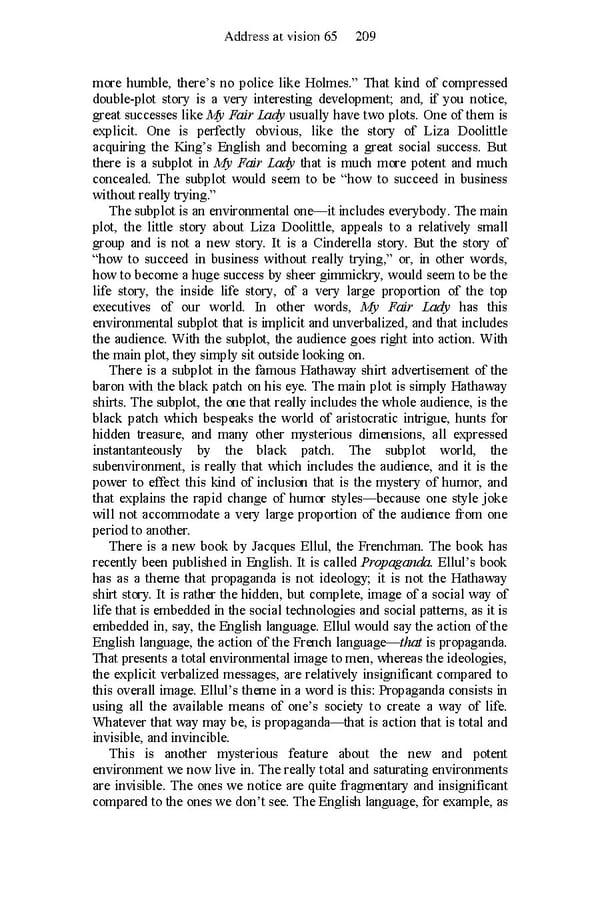Address at vision 65 209 more humble, there’s no police like Holmes.” That kind of compressed double-plot story is a very interesting development; and, if you notice, great successes like My Fair Lady usually have two plots. One of them is explicit. One is perfectly obvious, like the story of Liza Doolittle acquiring the King’s English and becoming a great social success. But there is a subplot in My Fair Lady that is much more potent and much concealed. The subplot would seem to be “how to succeed in business without really trying.” The subplot is an environmental one—it includes everybody. The main plot, the little story about Liza Doolittle, appeals to a relatively small group and is not a new story. It is a Cinderella story. But the story of “how to succeed in business without really trying,” or, in other words, how to become a huge success by sheer gimmickry, would seem to be the life story, the inside life story, of a very large proportion of the top executives of our world. In other words, My Fair Lady has this environmental subplot that is implicit and unverbalized, and that includes the audience. With the subplot, the audience goes right into action. With the main plot, they simply sit outside looking on. There is a subplot in the famous Hathaway shirt advertisement of the baron with the black patch on his eye. The main plot is simply Hathaway shirts. The subplot, the one that really includes the whole audience, is the black patch which bespeaks the world of aristocratic intrigue, hunts for hidden treasure, and many other mysterious dimensions, all expressed instantanteously by the black patch. The subplot world, the subenvironment, is really that which includes the audience, and it is the power to effect this kind of inclusion that is the mystery of humor, and that explains the rapid change of humor styles—because one style joke will not accommodate a very large proportion of the audience from one period to another. There is a new book by Jacques Ellul, the Frenchman. The book has recently been published in English. It is called Propaganda. Ellul’s book has as a theme that propaganda is not ideology; it is not the Hathaway shirt story. It is rather the hidden, but complete, image of a social way of life that is embedded in the social technologies and social patterns, as it is embedded in, say, the English language. Ellul would say the action of the English language, the action of the French language—that is propaganda. That presents a total environmental image to men, whereas the ideologies, the explicit verbalized messages, are relatively insignificant compared to this overall image. Ellul’s theme in a word is this: Propaganda consists in using all the available means of one’s society to create a way of life. Whatever that way may be, is propaganda—that is action that is total and invisible, and invincible. This is another mysterious feature about the new and potent environment we now live in. The really total and saturating environments are invisible. The ones we notice are quite fragmentary and insignificant compared to the ones we don’t see. The English language, for example, as
 Essential McLuhan Page 215 Page 217
Essential McLuhan Page 215 Page 217